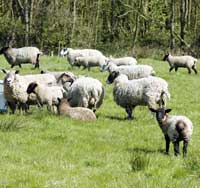Monthly ‘must do’s’: June 2011

1. Finish lambs off grass
Aim to market 20% more lambs off grass this season, as well-managed grazing is the most cost-effective way of finishing lambs at 14-20 weeks of age, says Chris Lloyd of EBLEX.
“Plan weaning to coincide with the availability of good grazing so lambs can grow quickly and ewes can regain body condition if they need to. Finishing too few lambs at grass is costly, and reduces grazing availability later on when the ewes need it before tupping.”
• For more information download the EBLEX BRP Action for Profit sheet 4: Better returns from planned weaning
2. Forage stocks assessment
With dry conditions in many parts of the UK reducing forage growth, calculating your forage inventory now and planning for next winter is essential to help reduce buying-in expensive feed, says Colin Robertson, technical consultant from Kingshay.
“Decide now on forward contracting forage replacers and consider options for taking wholecrop from existing cereal crops. Planting catch crops later in the season will help to boost on-farm feed supply, weather permitting.”
3. Alternatives to straw bedding
There is concern about straw availability, quality and price, so think about the coming harvest’s straw supply and consider finding alternatives to straw bedding, says Colin Stone, BPEX knowledge transfer manager.
BPEX is currently talking to producers who have experience of using alternatives to straw as bedding material for pigs, so it can advise on the options and their pros and cons.
4. Cooling checks
If producers have mister or cooling systems installed in pig buildings, now is the last chance to check them, says Lis Ravn, BPEX knowledge transfer manage.
“If the system was disconnected during winter, check that it is reconnected correctly and that it is linked into the environmental control system. Also check for blocked nozzles. It may be worth giving the system a thorough service and testing that everything is working as it should.”
5. Keep calving periods compact
Achieving a tight calving period requires discipline at serving time, says EBLEX livestock scientist Mary Vickers.
“Don’t be tempted to leave the bull in with the herd for much longer than nine to ten weeks.
“The benefits are numerous, including simpler cow and calf management, increased weaning weights, and fewer calf health problems. Remember that keeping cows which don’t conceive after three matings is not cost-effective.”
• For more information, download the EBLEX BRP manual: Optimising suckler herd fertility for better returns.
6. Give sows an annual worm check
For pig herds using Vetscore monitoring the presence or absence of “milk-spot” livers gives very useful information as to the prevalence of ascarid worms on the farm. However, it does not give any information as to the status of the sows, says Paul Thompson, vet consultant to pig breeding company ACMC.
He recommends faecal samples are screened at least annually for worm eggs to give an indication of the level of any infestations and the efficacy of the worming programme.
7. Calculate silage yields
“Dry conditions have reduced silage yields in many areas and are likely to affect other crops, so plan next winter’s feed requirements now,” says Liz Genever, EBLEX livestock scientist.
“Once first cut silage is in, calculate the volume of ensiled or baled forage, and compare with what livestock will need next winter.
“Then work out how much silage is needed from subsequent cuts, or how much additional forage or feed may have to be bought in.”
• For more information, download the EBLEX BRP manual: Optimising suckler herd fertility for better returns.
8. Keep calving periods compact
“Achieving a tight calving period requires discipline at serving time,” says EBLEX livestock scientist Mary Vickers.
“Don’t be tempted to leave the bull in with the herd for much longer than nine to ten weeks.
“The benefits are numerous, including simpler cow and calf management, increased weaning weights, and fewer calf health problems.
“Remember that keeping cows which don’t conceive after three matings is not cost-effective.”
• For more information, download the EBLEX BRP manual: Optimising suckler herd fertility for better returns.
9. The Full Value Pig
Angela Cliff, BPEX knowledge transfer manager: Get involved with Elanco Animal Health’s Full Value Pig initiative. With BPEX’s help, farms identify 100 piglets and weigh them at intervals from birth through to finishing. It evaluates the degree of uniformity in a pig population at every stage of production, not just the range of finished weights, and highlights instances where a disproportionate number of pigs show below-optimum growth. Angela Cliff: angela.cliff@bpex.ahdb.org.uk or 07967 788484.
MMD
